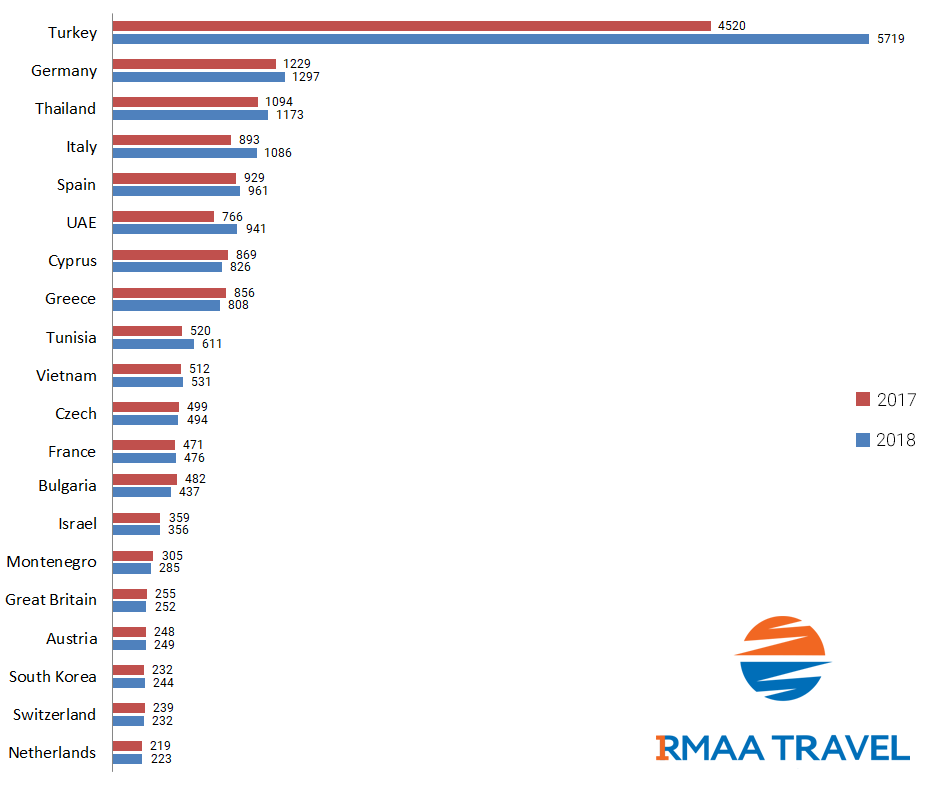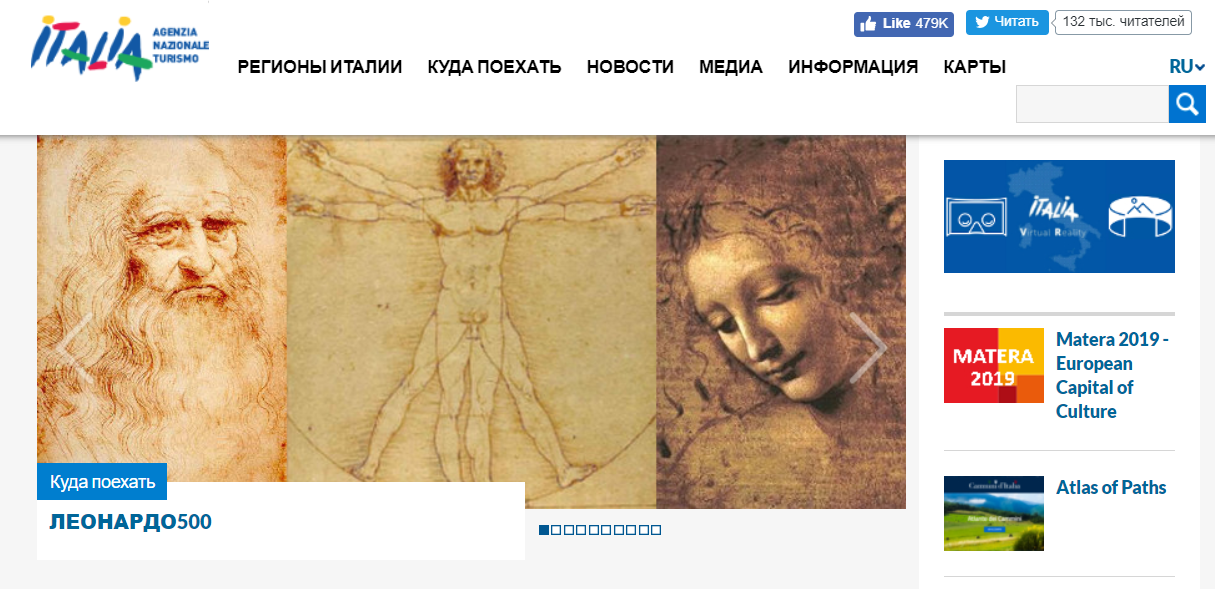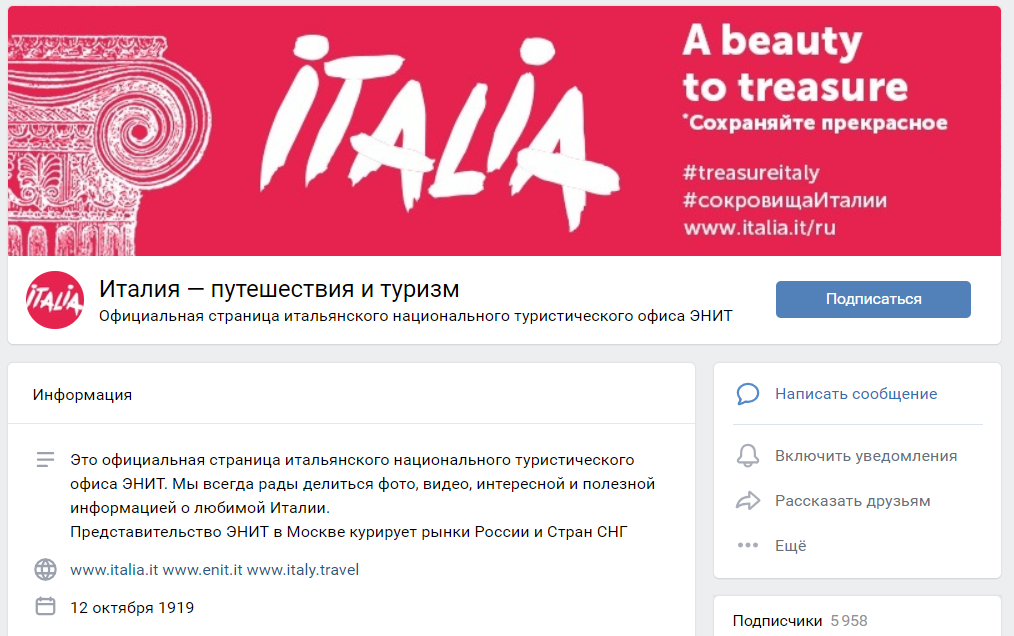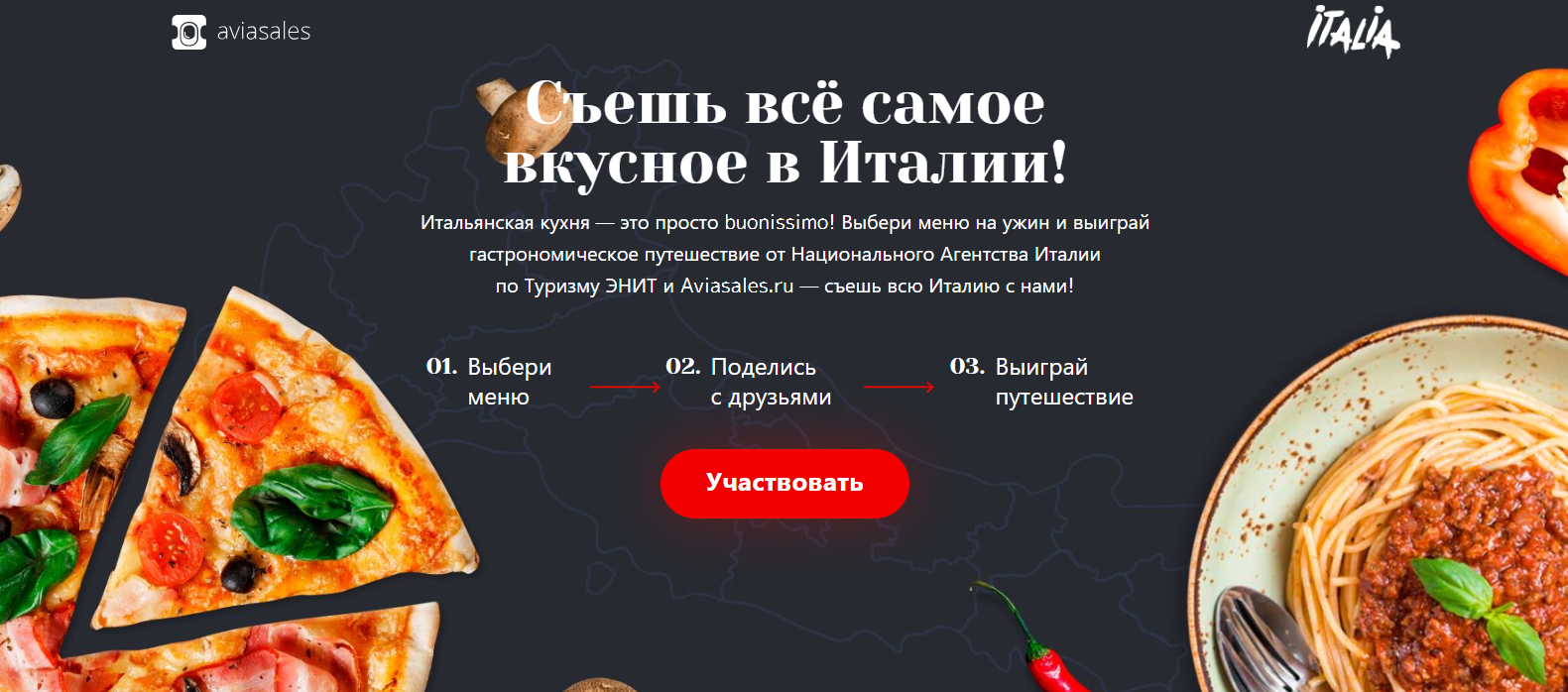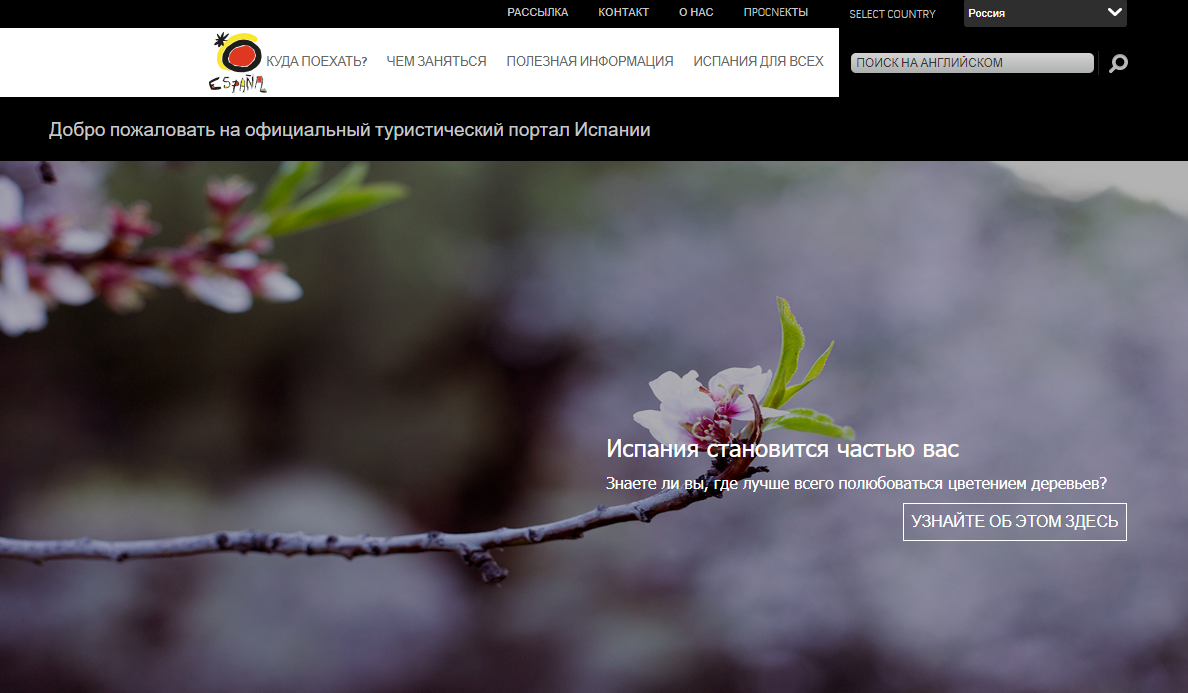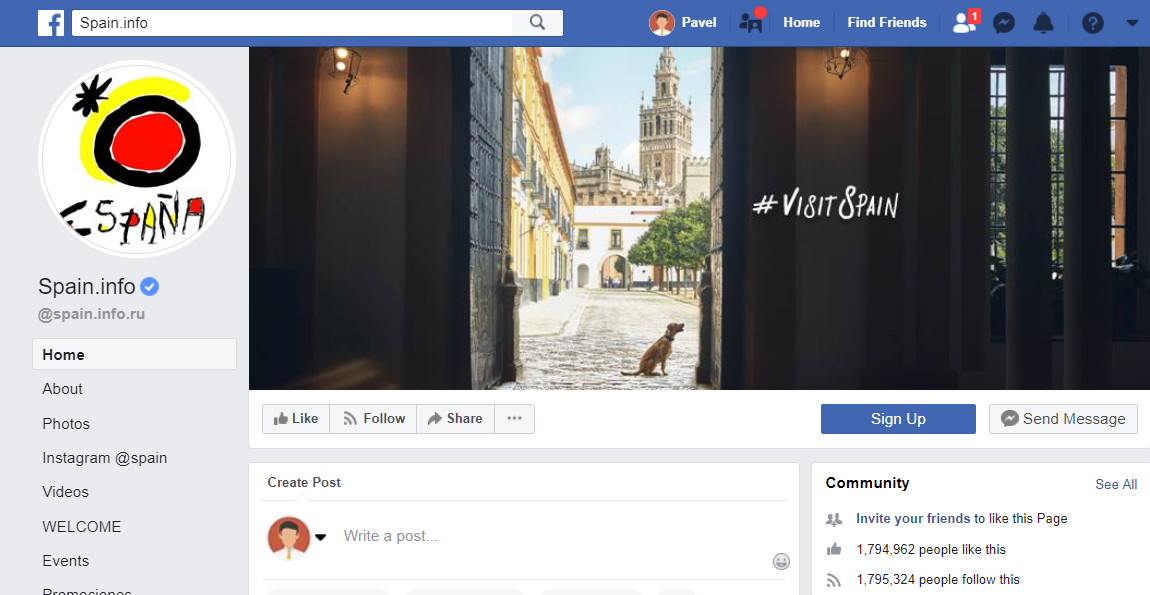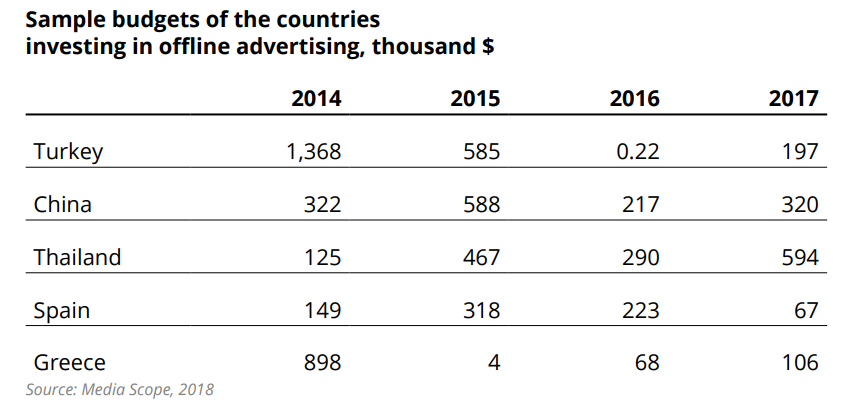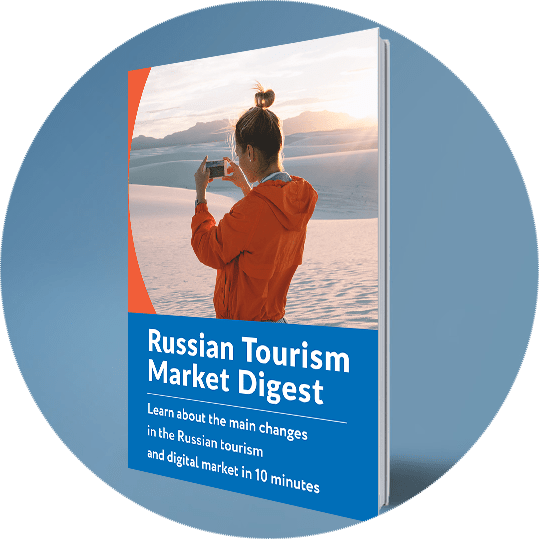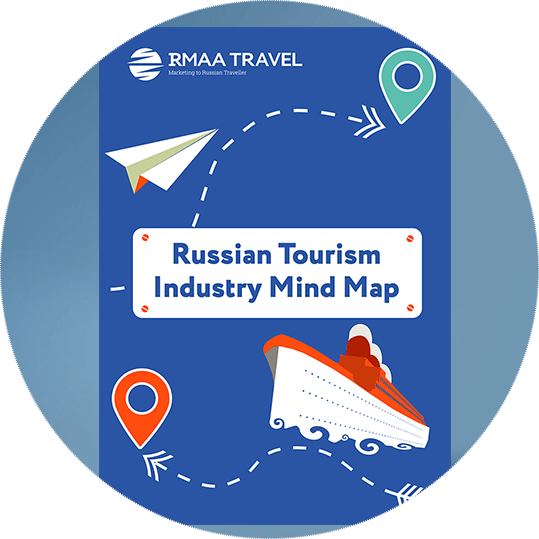Blog about successful marketing strategies in russia
Marketing of Northern and Southern European Tourist Destinations in Russia


DIGITAL MARKETING
Share this Post
European cities are annually visited by millions of Russian tourists. The statistics says it all: out of Top 20 popular countries among Russians, 12 are European. Some go there to admire architecture and survived cultural and historic landmarks of cities, others go to taste culinary delights of European cuisine, and still others try to visit famed resorts of Europe or go there on shopping tours.
Where Russians Went in 2018
As for the outbound flow to countries of the far abroad (except for bordering countries), in 2018 its share in the total number of trips hit almost half (45.7%) of the total number of trips of Russians abroad. In total, Russians made 20,353,710 trips to these countries last year, which is 10.8% more than in 2017. Russians were mostly going to these countries with travel purposes, including business tourism.
Top 20 countries of the far abroad, except for bordering countries, where most Russians went in 2018, look like this:
Source: Russian Federal State Statistics
The first twenty covers 88.9% of the whole Russian outbound tourist flow to the countries of the far abroad (except for bordering countries) or 58.9% of the whole outbound flow to foreign countries (except for post-Soviet states).
The list does not contain countries of the far abroad that border Russia (China, Mongolia, Poland, Finland, Lithuania, Latvia, and Estonia) because for the most part, as before, Russians went to these countries with non-tourism purposes. In 2018, Finland has the lead with 3.671 million trips (out of them, only 271 thousand indicated a purpose ‘tourism’), the second place is taken by China with 2.251 million trips (with 739 thousand out of them, according to the information from the Border Guard Service, with a purpose of ‘tourism’), and the third one by Estonia with 1.8 million trips (out of them, 29 thousand, according to the Border Guard Service of the Federal Security Service of Russia, were for ‘tourism’).
Top 5 Popular Southern and Northern European Countries among Russian Tourists
According to the statistics, five leaders in outbound tourism among countries of Southern and Northern Europe (except for bordering countries) are as follows:
- Italy – 1.086 million (+22%)
- Spain – 961 thousand (+3%)
- Greece - 808 thousand (-6%)
- Montenegro - 285 thousand (- 6%)
- Norway - 108 thousand (-6%)
Today we will talk about how these countries promote themselves in the Russian market.
Italy
Italy is one of the most interesting, unique, and beautiful countries in Europe. This country has its inimitable character, its charm, and its distinctive temper. This is a maritime country in uplands. Located in the south of Europe from the Alps to the Mediterranean Sea, it occupies a quite immense territory: the Apennine peninsula, the Sicily and the Sardinia Islands. Italy has access to five seas at once: Tyrrhenian, Ionian, Adriatic, Ligurian, and Mediterranean. The geography of this country is unique, tourism flourishes there all year round, as in summer one have relax on one of 5,000 Italian beaches, while in winter outdoor enthusiasts can go to mountains and have the time of their life in one of numerous mountain ski resorts.
Italy is so multifaceted that there is a plenty of ideas on how to spend your Italian holidays: sightseeing, shopping, weekend, culinary, and so-called event tours (for example, participation in famous Venetian Carnivals).
As for the use of online channels, the Italian Government Tourist Board (ENIT) tries to use technologies as much as possible. The agency is equipped with the following online channels:
- Website www.italia.it, optimized for various language versions (including Russian), where there is information on regions and cities of Italy, tips and recommendations to travelers, as well as useful information on rules of stay in the country.
- Social media accounts on Facebook, Twitter, Instagram and a Youtube channel (including channels of separate regions). There’s no question that presence in different social media is a huge advantage. However, pages are mostly maintained in English and Italian. To attract Russian tourists, the Italian Government Tourist Board uses only VKontakte, where all information is published in Russian.
- Italia VR app is an interesting solution where a traveler, using his or her smartphone, can learn more about Italian food, culture, and lifestyle. Although the app and video clips therein are not translated into Russian, they are so vivid and fascinating that after watching them one is tempted to feel live all the vivacity of colors and emotions that a tourist experiences in Italy.
- Special projects. We have oftentimes told in our blogs about one of the most popular Russian air ticket aggregators, Aviasales.ru. Apart from standard formats of advertising placement—ads on the website, in social media, and the aggregator’s app—Aviasales implements special projects together with national tourism offices of different countries in the Russian Federation, where a prize, as a rule, is a trip to one or another country.
Two special projects were organized jointly with ENIT: ‘I Want to Italy—And Basta!’ (2014) and ‘Eat Everything That Tastes Best in Italy’ (2018). The mechanics of such special projects, as a rule, is very simple: users must take a picture or choose a menu (like in our example) and share it on their pages in social media. In both special projects, the prize was a trip to Italy.
Such special projects let tourism offices cover the huge audience of users in Russia (as Aviasales spreads information on contests through all its channels, which means dozens of millions of visitors and subscribers), as well as, for example, collect a database of subscribers, like in the special project and ‘Eat Everything That Tastes Best in Italy’, where one of the conditions was entering a personal email.
Spain
Best-loved regions of Spain among Russian tourists are Catalonia, Valencia, Madrid, Canary Islands, Balearic Islands, Basque Country, Murcia, and Galicia. The average length of stay in the country in 2017 was 10 days.
A research conducted by Ostelea, School of Tourism and Hospitality, showed that Russian tourists are real gourmands. They took the second place in Spain as per expenses on culinary specialties. As it turned out, on average our tourists spend €346 on delicacies during a trip, which is much more than many other foreigners do.
How is Spain presented in the Russian Internet?
The Spanish Institute of Tourism is mostly presented in the Russian Internet via traditional channels:
- Website www.spain.info is partially translated into Russian: the site navigation is translated, but there is no content in Russian in some sections, and, clicking on a link, a user switches to texts in English.*
*In such cases, when your website has a language choice, but some sections lack information in this language, we still recommend hiding these sections until the content is adapted.
- Social media accounts. The content adapted for the Russian-speaking audience is presented on Facebook. Here, apart from pictures of Spanish beauties, subscribers can follow announcements of events organized by the Spanish Department of Tourism in Russian cities. Still, the main part of content is colorful pictures of urban and regional landscapes of Spain with short descriptions. On Instagram, all pictures are made by the very users—luckily, modern travelers love sharing not only their feelings, but also vibrant pictures in social media.
- On the Youtube of the Spanish Institute of Tourism, there is a series of 360 degrees videos, getting through which, a user can visit a palace in Madrid, walk on a beach, cook traditional Spanish dishes under the guidance of a local chef, as well as dip into an incredible atmosphere of La Tomatina.
Greece
In 2017-2018, there was a cross-cultural year of tourism between Russia and Greece. Despite of a minor fall of the flow of Russian tourists to Greece—in 2018, the number of Russian tourists in the country dropped by 5%, compared to 2017—Director of the Regional Office of the Greek National Tourism Organization in Russia and CIS, Polykarpos Efstathiou, estimated this season as a successful one.
– This season was not easy. We faced a lot of factors that influence the activity of the tourist flow: these are ruble instability, high competition with many neighboring countries, new travel destinations, and the World Cup.
Besides, Mr. Efstathiou noted that the travel policy of the Ministry of Tourism focuses on the idea of marketing Greece as a destination for a year-round recreation. We can see work on this strategy in 2019.
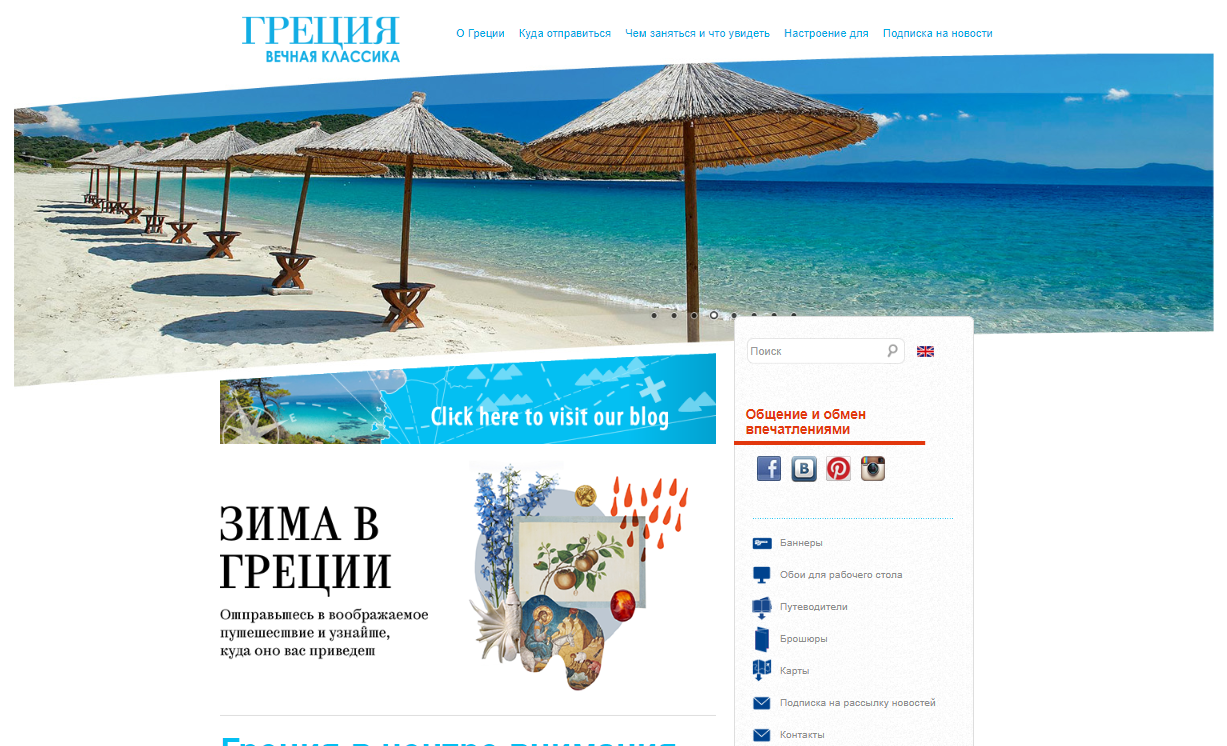
- So, for example, on the main page of the official website of the Greek National Tourism Organization there is a link to an interesting project ‘Winter in Greece’, clicking on which, a traveler switches to a landing page with a quest: to move to a next step, he or she needs to make a choice (with whom, where, and how to move further).
 At every next step, there is interesting information on different tourist attractions of the country, cultural and culinary traditions. In the end of a ‘virtual trip’, a user sees a fortune-telling message (by the way, it is different every time—we checked it several times), which he or she can share on his or personal page in social media or buy tickets to Greece.
At every next step, there is interesting information on different tourist attractions of the country, cultural and culinary traditions. In the end of a ‘virtual trip’, a user sees a fortune-telling message (by the way, it is different every time—we checked it several times), which he or she can share on his or personal page in social media or buy tickets to Greece.
‘You learned about your Greek origins and inherited a vineyard’
As a result, according to GNTO, during winter months 3.5 thousand people walked through the travel quest, glanced at islands and mountains, and learned what Greece can be like off-season. There were ‘travelers’ from Russia, Ukraine, Greece, USA, Germany, France, Cyprus, Czech Republic, and Great Britain.
- Unlike many other offices of foreign countries in Russia, GNTO actively maintains pages on VKontakte (5,800 subscribers), Facebook and Instagram (13,500 subscribers) in Russian. It is worth noting that the GNTO website is fully translated into Russian.
The pages present information on places of interest, ideas for recreation, exciting publications about festivals and carnivals and a lot of other useful and interesting information, which is accompanied by pictures made by the very users in different parts of the country.
Marketing of Greece as a destination for a year-round recreation has also echoed in the last video Greece-A 365 day destination uploaded on channel Visit Greece.
Montenegro
The guiding motive for guests from Russia to come is wonderful Montenegrin beaches, sun and sea (64.5%), as well as nightlife and parties. Many tourists are interested in attractive national parks of Montenegro, especially in the north of the country (Durmitor and Biogradska Gora), as well as tasting of traditional cuisine and wine (Lake Skadar, national park). In winter, Russians are attracted by mountain ski resorts.
Besides, during their stay in Montenegro Russian tourists often visit religious sites, such as the Monastery of Ostrog, the Cetinje Monastery, Cetinje / Mausoleum of Petar II Petrović-Njegoš, the canyon of the Morača River, and the Morača Monastery. The average stay of tourists from Russia in Montenegro is 9.21 days, which is more than average, compared to stay of tourists from other countries. Besides, Russians do not need a visa to stay there for up to 90 days.
Unfortunately, neither the website nor social media of the National Tourist Organization of Montenegro are optimized for Russian tourists. We only found a video ‘All beauty of Montenegro’ on their Youtube channel, from where tourists can learn more about the country’s landmarks.
The content of the organization’s pages on Facebook and Instagram is mostly duplicated—this is user generated content (colorful and bright pictures with short descriptions to them).
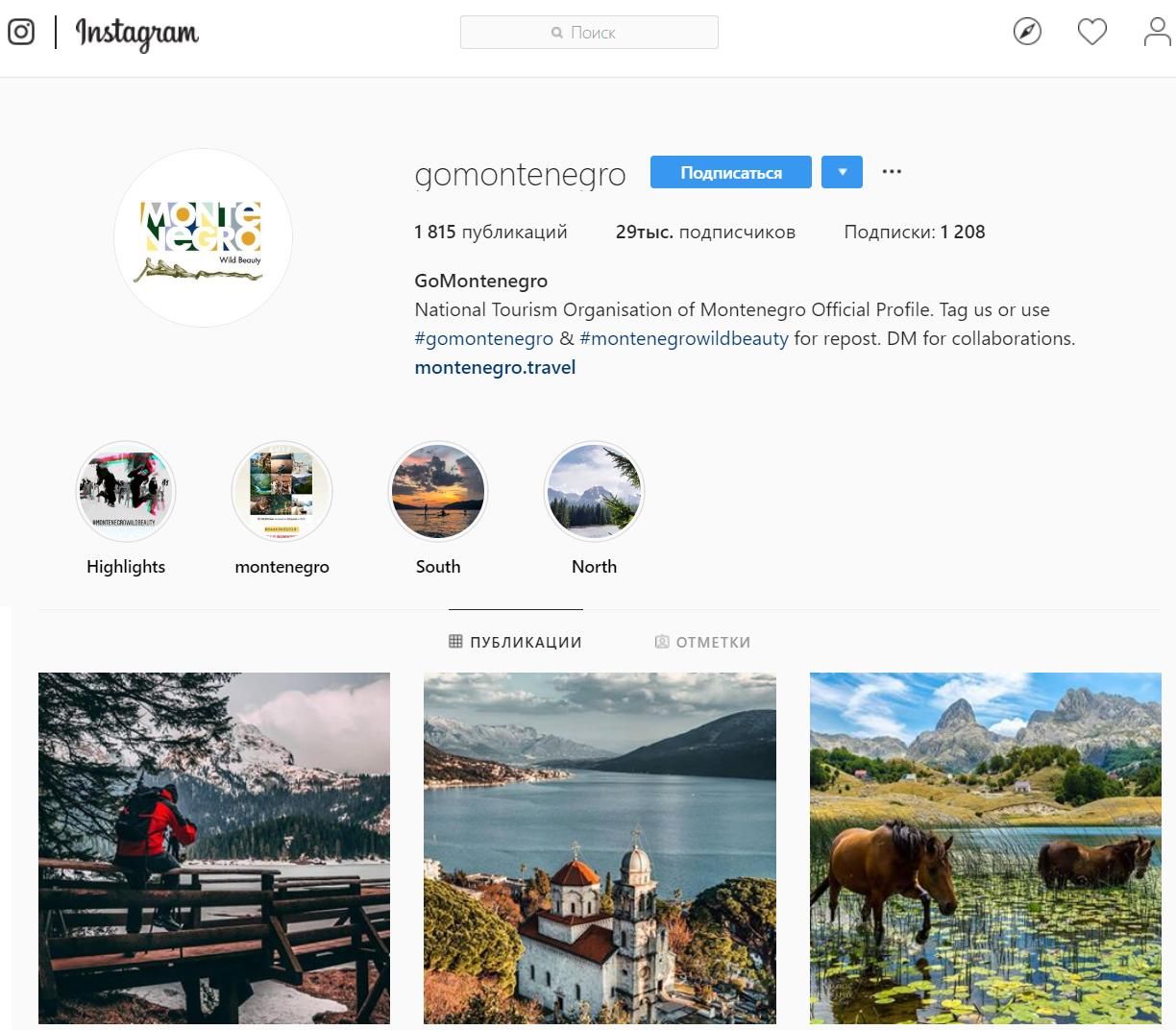
Norway
In actual fact, Top 5 must include much more countries from Northern Europe (Finland, Estonia, Lithuania…), but, as we noted before, Russians basically go to these countries bordering Russian with non-tourism purposes, that is why Norway closes our list of favorite countries of Southern and Northern Europe among Russian tourists.
According to the statistics of the World Tourism Organization (UNWTO), 2017 became a record-breaking one for Norwegian tourism. Thanks to a good summer and a relatively low exchange rate of Norwegian krone, the year was a success. The growth in the number of tourists mostly hit summer months, while the regions that saw the most significant growth are Northern Norway and Fjord Region. A notable thing is that in 2017, the number of overnight stops of Russian tourists grew for the first time since 2014.
- Webiste of VisitNorway in Russia www.visitnorway.ru is adapted for the Russian-speaking audience, and as for those who only start learning the country and wants to arrange the route in advance, the websites presents a great map with filters, by which you can choose venues that are of interest for you and map a route of a future tour around them.
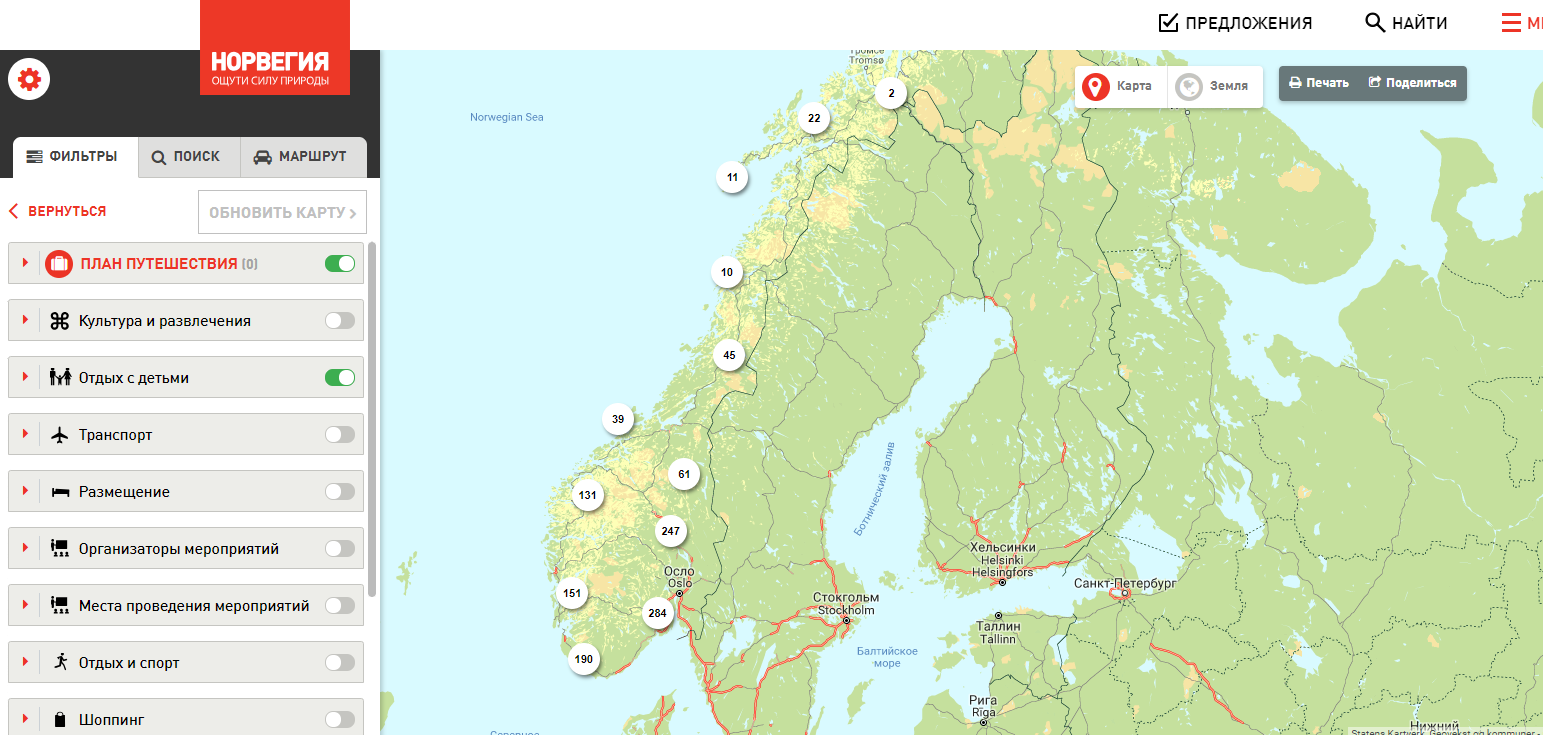
- Social media accounts are also adapted for the Russian-speaking audience. They present information on the travels across Norway—news, pictures, tips, contests, discussions, and many others. On VK, the VisitNorway page has nearly 15,000 subscribers.
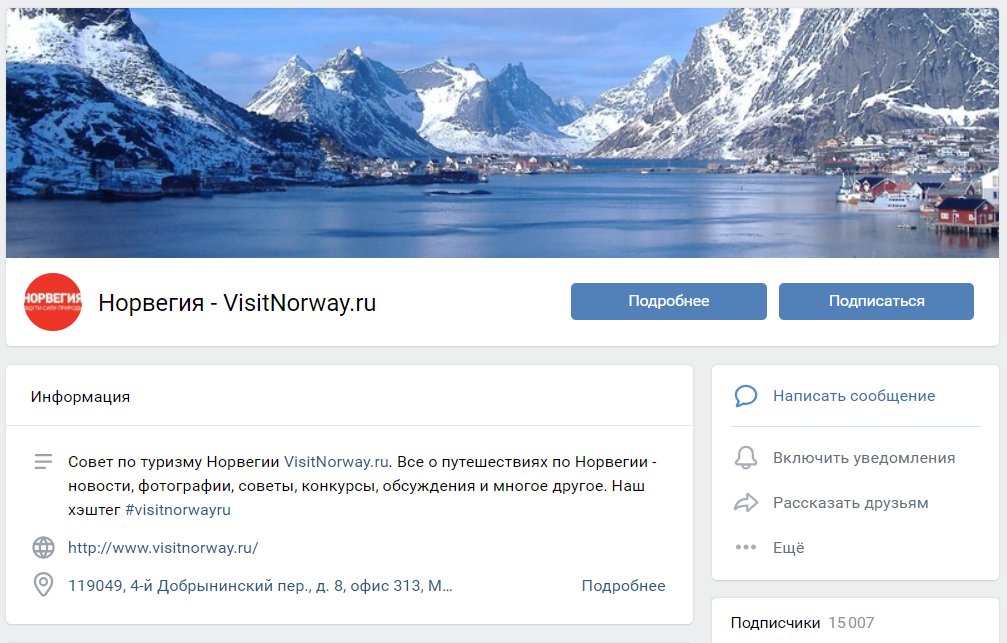
Content on VK, Facebook, and Twitter is duplicated. Content on Instagram is users’ videos and pictures with amazing landscapes of Norway, after viewing which there is a really strong desire to visit this fabulous Northern country.
What about Offline?
In our study “Russian Tourism Market Report: Trends, Analysis & Statistics”, several chapters are devoted to an overview of how different countries promote themselves in the Russian market, how much they spend on advertising, and what channels they use.
According to our research data analysis, tourism ministries are conservative in the choice of advertising channels and prefer to place advertising on TV, radio, and print media.
What Do Russian Tourists Think of Europeans?
The stereotypes can contribute to tourism, but can also create obstacles and give rise to concerns about certain nations and countries. If you know stereotypes, you can use them in advertising to the best effect and represent your country in a favourable light.
In our study “Russian Tourism Market Report: Trends, Analysis & Statistics”, we made a list of the most popular stereotypes about citizens of different countries, including Greece and Spain.
Greeks in the eyes of Russians
— They don’t like to work (lazy)
— They do not pay taxes
— They think the world revolves around them
— All the Greeks dance Sirtaki
— They drink a lot of ouzo and retsina
— They are very hairy
— They are hyper-consumers
— They talk very loudly, almost shouting
Spaniards in the eyes of Russians
— They are honest
— They are unhasting in business
— They are passionate about women
— They respect and care about family
— They like art, dancing, and they are very musical
— They like corrida
— They talk very loudly, almost shouting
Conclusion
We got only a little bit of insight into how countries of Northern and Southern Europe promote their travel destinations online. If you promote a travel destination or are just going to enter the Russian market, you must monitor how your competitors do it.
By the way, if you promote a country or a resort in Asia, from our article Marketing of Asian Tourist Destinations in Russia. How Do Asians Gain the Attention of Russian Tourists? you will learn more how the most popular Asian countries promote themselves in the Russian travel market.
Meanwhile, experts from RMAA Travel will gladly help you create and deliver on a marketing strategy to enter the travel market of Russia.
Travel Research
The Russian Tourism Market Report: Trends, Analysis & Statistics | 2019. How to impress Russian tourists and attract them to your country
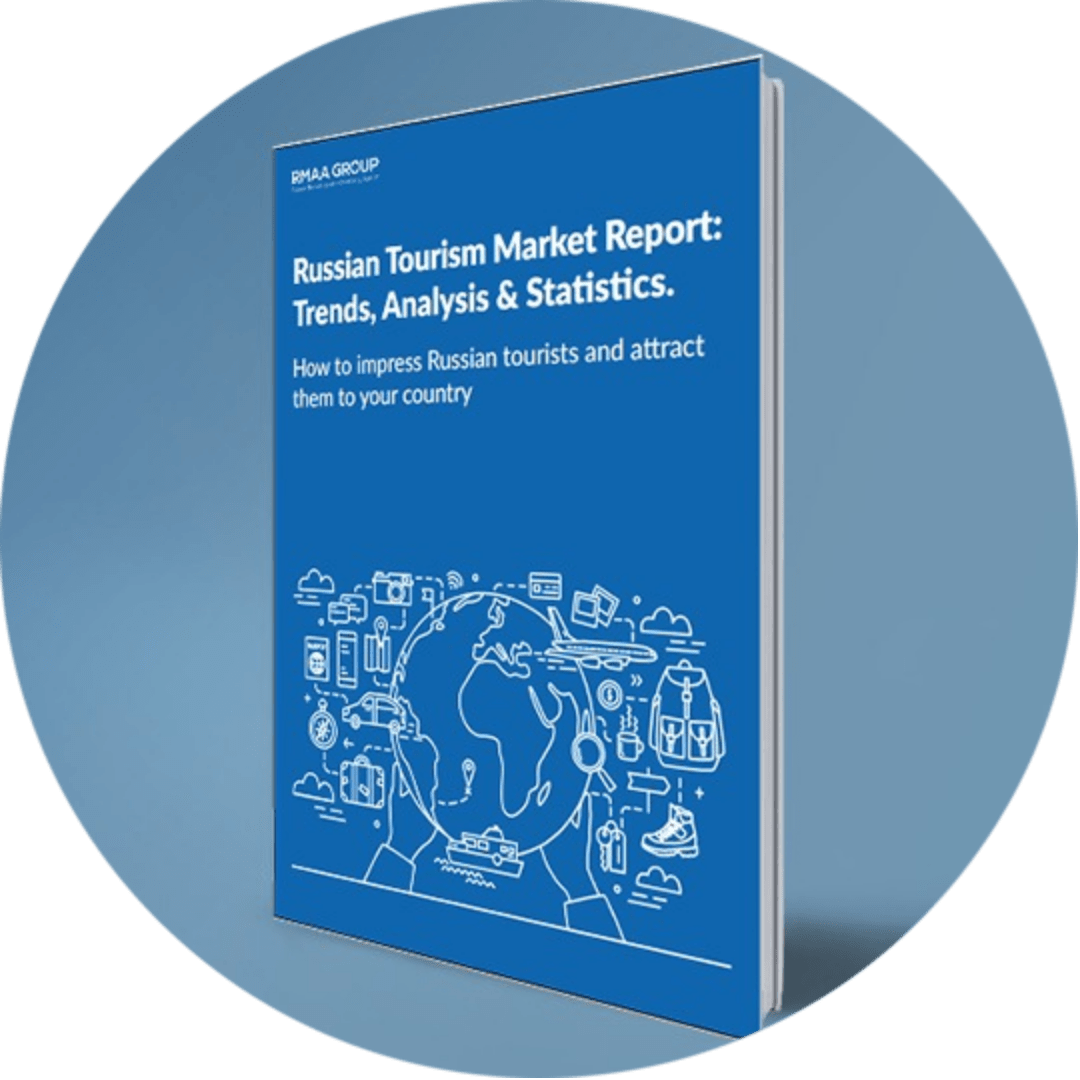
Ready to partner with the specialists in Russian travel marketing and advertising?
About the Author
Head of Digital, editor-in-chief of the RMAA Agency Blog
Join 2,000+ of your Peers!
Get our latest articles delivered to your email inbox and get our exclusive White Paper "Digital Marketing in Russia. Finding your customers on the internet" for FREE!
You will be the first to know about Russian marketing insights,
news and updates from our agency.
Stay tuned!
We're updating our website's design step by step, so some pages may look different. Thank you for your understanding.
Got it









